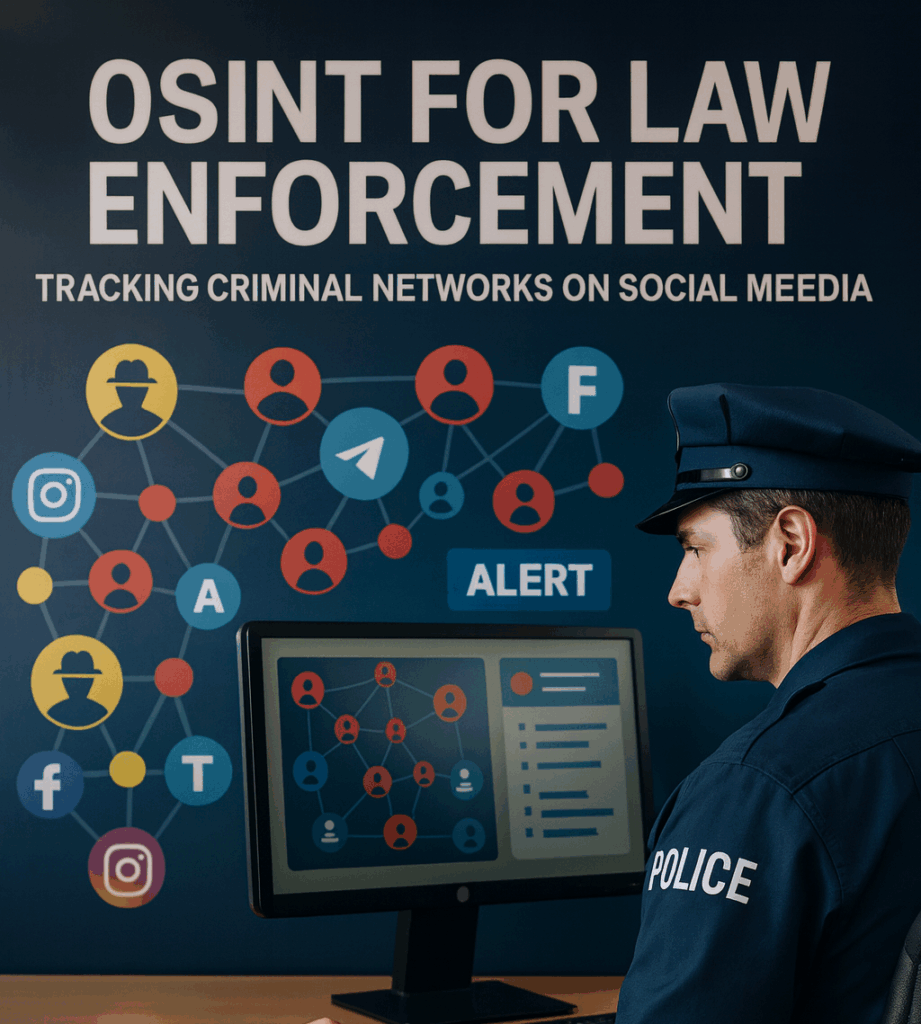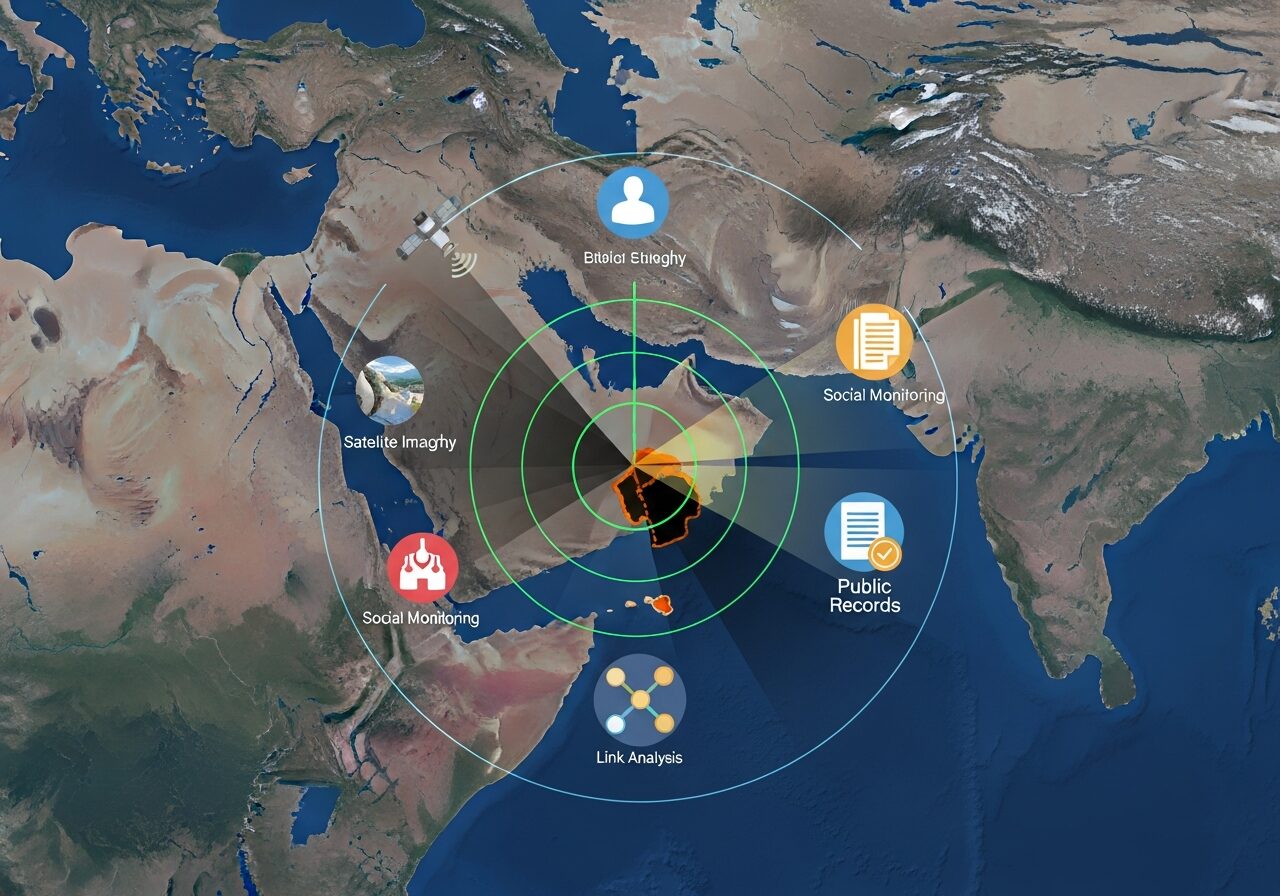Social Media as a New Crime Frontier
The digital revolution has fundamentally transformed how criminals operate, communicate, and organize. What once required face-to-face meetings in shadowy locations now happens in plain sight across social media platforms, messaging apps, and online forums. Criminal networks have discovered that platforms like Facebook, Instagram, Telegram, and TikTok offer unprecedented opportunities for recruitment, coordination, and even conducting illegal business, making OSINT for law enforcement essential to tracking and disrupting these digital operations
For law enforcement agencies worldwide, this shift presents both challenges and opportunities. Traditional investigative methods, while still valuable, are no longer sufficient to combat digitally-savvy criminal organizations. The solution lies in Open Source Intelligence (OSINT) – the systematic collection and analysis of publicly available information to generate actionable intelligence.
Real-time, open-source monitoring has become critical for digital policing. Criminal activities that once took weeks to uncover through traditional methods can now be detected in hours through sophisticated OSINT techniques. This article explores how law enforcement can harness the power of OSINT for law enforcement social media investigations to stay ahead of evolving criminal networks.
What Is OSINT for Law Enforcement?
Open Source Intelligence (OSINT) refers to the collection, analysis, and dissemination of information gathered from publicly available sources. For law enforcement, OSINT represents a goldmine of actionable intelligence that can be legally obtained without warrants or special permissions, as it involves information that individuals and organizations have voluntarily made public.
The core OSINT sources for law enforcement include:
- Social Media Platforms: Facebook, Instagram, Twitter, TikTok, LinkedIn, and emerging platforms where users share personal information, locations, connections, and activities.
- Messaging Apps and Forums: Telegram channels, Discord servers, Reddit communities, and specialized forums where criminal networks often recruit and coordinate.
- Public Records and Databases: Court records, business registrations, property records, and government databases that provide context and verification for social media intelligence.
- News and Media Sources: Local news, blogs, and online publications that may contain relevant information about criminal activities or individuals.
- Digital Footprints: Website registrations, online reviews, professional profiles, and any other digital traces individuals leave across the internet.
OSINT for law enforcement matters offers several critical advantages, including being cost-effective compared to traditional surveillance methods, operating within legal boundaries due to the information’s public availability, providing real-time intelligence to prevent crimes in progress, and scaling efficiently to monitor multiple targets simultaneously.
The key to successful open-source intelligence LEO operations lies in combining traditional investigative skills with modern digital investigation tools for police that can process vast amounts of data quickly and identify meaningful patterns.
Why Social Media Is Central to Criminal Network Mapping
Social media platforms have become the nervous system of modern criminal networks, offering unprecedented visibility into their structure, operations, and intentions.
Real-time Activity Tracking
Criminal organizations use social media for immediate communication and coordination. Public Facebook groups serve as recruitment grounds for various illegal activities, from drug trafficking to human smuggling. Telegram channels provide semi-encrypted communication for sharing operational details, while Instagram stories offer temporary communication that criminals believe leaves minimal digital evidence.
Law enforcement agencies can monitor these activities in real-time, gaining insights into planned operations, changes in leadership, and emerging threats. Unlike traditional surveillance, which requires physical presence and significant resources, social media monitoring can track multiple criminal actors simultaneously across different geographic locations.
Communication and Recruitment Channels
Criminal networks have discovered that social media platforms offer efficient recruitment mechanisms. Gangs use Instagram and TikTok to glorify criminal lifestyles and attract new members. Human traffickers use Facebook groups and messaging apps to identify and groom potential victims. Fraud syndicates recruit money mules through LinkedIn and other professional networks.
These platforms also serve as coordination centers where criminal groups plan operations, share intelligence about law enforcement activities, and manage their criminal enterprises. The challenge for law enforcement is distinguishing between legitimate social media use and criminal communication patterns.
Behavioral and Network Signals
Social media analysis reveals behavioral patterns and network structures that are invisible through traditional investigative methods. By analyzing likes, follows, hashtags, and group affiliations, investigators can map criminal networks with unprecedented precision.
For example, if multiple individuals consistently like posts from the same accounts, participate in similar groups, or use identical hashtags, they may be part of the same criminal organization. Geolocation data from posts can reveal operational territories, meeting locations, and criminal hotspots.
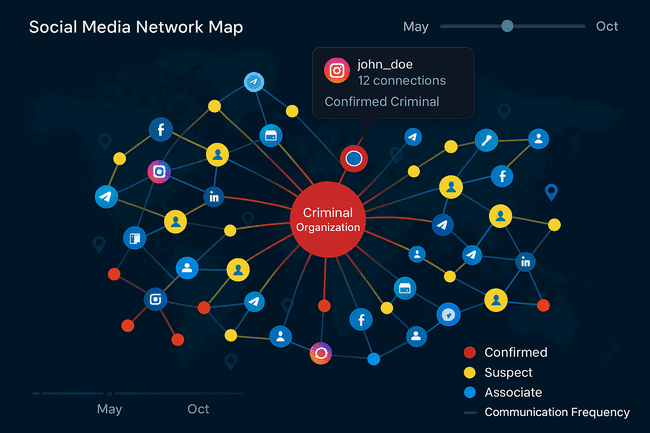
The Social Media Crime Ecosystem
Platform-Specific Criminal Activities
Facebook and Instagram: These platforms serve as primary recruitment grounds for various criminal organizations. Drug trafficking networks use coded language in posts and stories to advertise products and coordinate sales. Human trafficking operations recruit victims through fake modeling agencies and employment opportunities. Fraud syndicates create fake profiles to build trust with potential victims.
Telegram: The platform’s channel feature allows criminal organizations to broadcast information to large audiences while maintaining operational security. Drug dealers use Telegram channels to advertise products, share customer reviews, and coordinate deliveries. Terrorist organizations use the platform for recruitment and operational planning.
TikTok: Short-form video content is increasingly used to glorify criminal lifestyles and recruit young people into gang activities. Criminal organizations use viral challenges and trends to spread coded messages and identify potential recruits.
Discord: Gaming-focused communities provide cover for criminal coordination. Criminal organizations create private servers for operational planning, while using public servers for recruitment and community building.
OSINT Techniques for Identifying Criminal Actors Online
Effective social media investigations require sophisticated analytical techniques that go beyond simple keyword searches.
Handle Analysis and Pattern Detection
Criminal actors often use multiple aliases and accounts across different platforms, but they frequently reuse usernames, email addresses, or profile elements that create identifiable patterns. Advanced OSINT practitioners use cross-platform identity resolution to connect seemingly unrelated accounts to the same individual.
Pattern detection involves analyzing communication styles, posting schedules, language patterns, and behavioral quirks that remain consistent across different identities. Even when criminals attempt to obscure their identities, subtle patterns in their digital behavior often reveal their true connections and activities.
Link Analysis for Network Mapping
Link analysis transforms isolated pieces of information into comprehensive network maps that reveal the structure and hierarchy of criminal organizations. By examining who communicates with whom, when they communicate, and what they discuss, investigators can identify leaders, operational cells, and support networks.
This technique involves analyzing shared assets (such as phone numbers, addresses, or financial accounts mentioned in posts), mutual connections, collaborative activities, and temporal patterns in communication. The result is a visual network map that shows how criminal organizations are structured and how information flows through them.
Sentiment and Intent Monitoring
Natural Language Processing (NLP) technology enables law enforcement to detect threats, operational planning, and recruitment language within the massive volume of social media content. Advanced algorithms can identify when conversations shift from general discussion to operational planning, when individuals express intent to commit crimes, or when groups are actively recruiting new members.
Sentiment analysis helps investigators prioritize threats by identifying communications that indicate imminent criminal activity versus general criminal discussion. This capability is crucial for preventing crimes in progress and allocating investigative resources effectively.
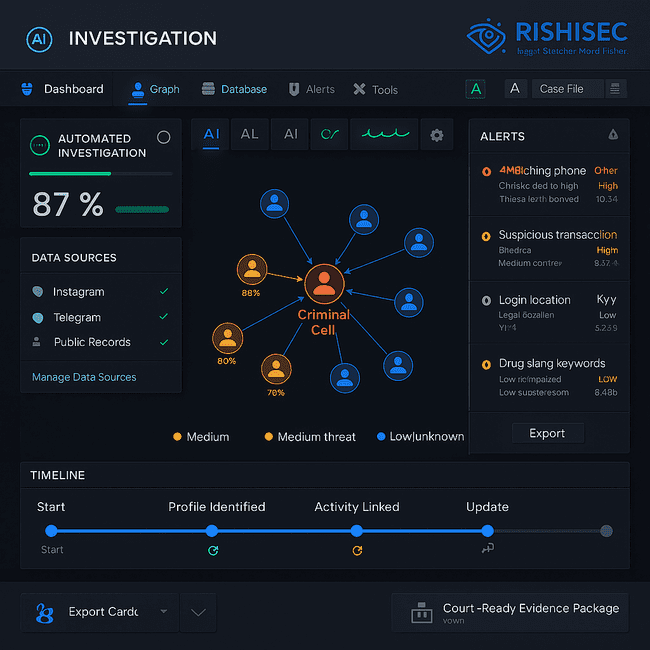
Tools and Platforms Law Enforcement Use to Monitor Social Media
The complexity of modern social media investigations requires sophisticated tools that can collect, analyze, and visualize vast amounts of data efficiently.
Kindi represents the next generation of OSINT tools for police, offering AI-driven automation that dramatically reduces investigation time. Unlike traditional manual methods, Kindi’s intelligent agents can conduct complete multi-step investigations with a single click, automatically connecting data points across multiple platforms and sources. Its interactive link graphs instantly visualize how people, places, and events connect, eliminating the tab-hopping and guesswork that slows down traditional investigations.
Maltego provides powerful link analysis capabilities for mapping relationships between individuals, organizations, and digital assets. It excels at transforming raw data into actionable intelligence through visual network analysis.
ShadowDragon offers comprehensive social media intelligence gathering with automated monitoring and alerting capabilities. It specializes in real-time monitoring of multiple platforms simultaneously.
SocialNet focuses on deep dive analysis of individual social media profiles and their connections, providing detailed behavioral analysis and relationship mapping.
The key advantage of AI-assisted platforms like Kindi lies in their ability to process parallel investigations simultaneously without slowing down. Traditional manual methods require investigators to spend hours or days collecting information that automated systems can gather in minutes. This efficiency enables law enforcement agencies to significantly scale their social media intelligence for law enforcement operations.
Modern OSINT platforms also offer custom workflow builders that allow agencies to design investigation processes visually, requiring no technical skills while enabling infinite reusability of successful investigative frameworks.
Case Example – Disrupting a Smuggling Network via Instagram and Telegram
Consider a fictionalized but realistic scenario where law enforcement discovers a human smuggling network operating across multiple social media platforms.
- Initial Discovery: Investigators notice unusual patterns in Instagram posts from a specific geographic region, with multiple accounts posting similar content using coded language and specific hashtags. The posts appear to advertise “travel services” but use terminology consistent with human smuggling operations.
- Network Mapping: Using advanced OSINT tools like Kindi, investigators quickly map connections between the suspicious Instagram accounts. The automated link analysis reveals a network of 47 connected accounts across Instagram, Telegram, and Facebook, with clear hierarchical relationships indicating operational structure.
- Communication Analysis: Telegram channel monitoring reveals detailed operational planning, including routes, pricing, and coordination with corrupt officials. AI-powered sentiment analysis identifies communications indicating imminent smuggling operations, allowing law enforcement to prioritize their response.
- Geographic Intelligence: Geotagged posts and check-ins reveal operational territories, safe houses, and border crossing points. Timeline analysis shows patterns in smuggling operations, revealing optimal times for interdiction.
- Operational Outcome: Within 72 hours of initial discovery, investigators have mapped the entire network, identified key players, and gathered evidence of ongoing criminal activity. Coordinated operations resulted in 23 arrests across three countries and the rescue of 15 trafficking victims.
This investigation, which would have taken months using traditional methods, was completed in days using automated OSINT techniques and AI-powered analysis tools.

Challenges in OSINT for Social Media Investigations
Despite its power, OSINT for social media investigations faces significant challenges that law enforcement must navigate carefully.
Privacy and Legal Boundaries
GDPR regulations in Europe and various privacy laws in other jurisdictions create complex legal frameworks for social media monitoring. While publicly posted information generally doesn’t require warrants, investigators must understand the legal boundaries of their collection and analysis activities.
Geolocation tracking presents particular challenges, as precise location data may be considered private even when generally shared on social media platforms. Constitutional protections in the United States and similar rights in other countries require law enforcement to balance investigative effectiveness with individual privacy rights.
Platform Evasion Tactics by Criminals
Criminal organizations continuously adapt their tactics to avoid detection. They increasingly use burner accounts that are quickly abandoned, migrate to encrypted chat applications, and move operations to dark web platforms that are harder to monitor.
Sophisticated criminal groups employ operational security (OPSEC) practices, including using coded language, avoiding direct communication about illegal activities, and deliberately posting misleading information to confuse law enforcement monitoring.
Data Overload and False Positives
The sheer volume of social media content creates significant analytical challenges. Without proper automation and smart filtering, investigators can become overwhelmed with irrelevant information, leading to missed threats and wasted resources.
False positives are another major concern, as automated systems may flag legitimate activities as suspicious, requiring human analysts to verify and validate automated findings. This challenge emphasizes the need for sophisticated AI systems that can distinguish between genuine threats and benign activities.
Best Practices for Law Enforcement OSINT Success
Successful implementation of digital investigation techniques requires systematic approaches and ongoing training.
Develop Standard Operating Procedures: Agencies must establish clear SOPs for digital investigations that address legal compliance, evidence preservation, and analytical standards. These procedures should specify when and how to use different OSINT techniques and tools.
Invest in Analyst Training: Effective OSINT requires specialized skills in digital forensics, social media analysis, and ethical considerations. Regular training ensures investigators stay current with evolving platforms and techniques while maintaining legal and ethical standards.
Integrate with Case Management: OSINT findings must be seamlessly integrated with existing case management systems to ensure evidence integrity and support prosecution efforts. This integration includes proper documentation, chain of custody, and court-ready evidence formatting.
Foster Inter-agency Collaboration: Criminal networks operate across jurisdictions, requiring law enforcement agencies to share intelligence and coordinate operations. Effective OSINT programs include mechanisms for secure information sharing and joint operations.
These police OSINT best practices ensure that agencies can effectively leverage social media intelligence while maintaining legal and ethical standards.
The Role of AI and Automation in Social Media Investigations
Artificial intelligence and automation represent the future of law enforcement social media monitoring, offering capabilities that far exceed human analytical capacity.
Kindi’s AI-powered approach exemplifies this transformation. Its automated multi-step investigations can process vast datasets and identify patterns that would take human analysts weeks to discover. The platform’s parallel processing engine handles multiple investigations simultaneously, dramatically increasing operational efficiency.
AI-powered detection capabilities include identifying language shifts that indicate operational planning, recognizing image reuse across different accounts and platforms, and mapping complex link networks that reveal criminal organization structures. These capabilities reduce analyst burden while increasing the accuracy and speed of investigations.
Machine learning algorithms continuously improve their detection capabilities by learning from successful investigations and analyst feedback. This means that OSINT tools become more effective over time, automatically adapting to new criminal tactics and communication patterns.
Real-time processing enables immediate alerting when specific criteria are met, allowing law enforcement to respond to developing situations quickly. This capability is crucial for preventing crimes in progress and disrupting criminal operations before they can cause harm.
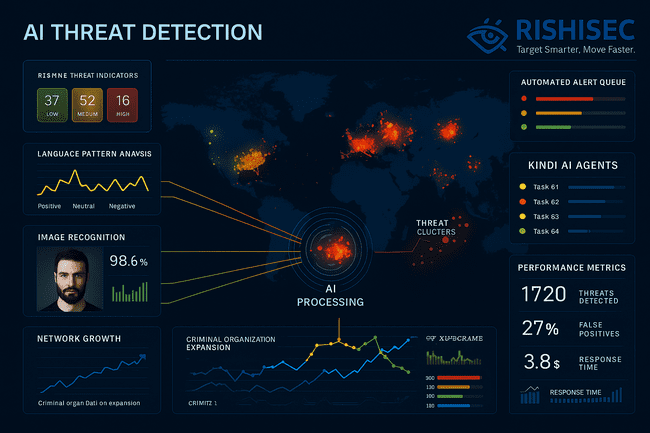
Conclusion
The digital transformation of criminal activity demands equally sophisticated responses from law enforcement. Social media platforms have become the primary communication and coordination channels for criminal networks, making OSINT for law enforcement social media investigations not just valuable but essential.
The integration of AI-powered tools like Kindi with traditional investigative techniques offers unprecedented opportunities to understand, track, and disrupt criminal networks. By automating complex analytical processes and providing real-time intelligence, these tools enable law enforcement agencies to stay ahead of rapidly evolving criminal tactics.
Success in digital investigations requires more than just technology – it demands ongoing training, clear procedures, legal compliance, and inter-agency cooperation. Agencies that invest in comprehensive OSINT capabilities while maintaining ethical standards will be best positioned to protect their communities in the digital age. The criminals have already embraced digital tools and techniques. It’s time for law enforcement to meet them on this new battlefield with equally advanced capabilities and an unwavering commitment to justice.
Stop wasting hours chasing false positives, let Kindi do the heavy lifting. Our AI-powered OSINT platform automates social media monitoring, maps criminal networks instantly, and gives law enforcement the context needed to act fast. Request a Demo of Kindi Today

